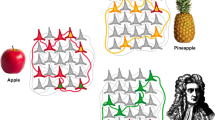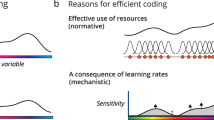Abstract
Learning processes allow the central nervous system to learn relationships between stimuli. Even stimuli from different modalities can easily be associated, and these associations can include the learning of mappings between observable parameters of the stimuli. The data structures and processing methods of the brain, however, remain very poorly understood. We investigate the ability of simple, biologically plausible processing mechanisms to learn such relationships when the data is represented using population codes, a coding scheme that has been found in a variety of cortical areas. We require that the relationships are learned not just from the point of view of an omniscient observer, but rather the network itself must be able to make effective use of the learned relationship, within the population code representations. Using a form of Hebbian learning, local winner-take-all, and homeostatic activity regulation away from the periphery, we obtain a learning framework which is able to learn relationships from examples and then use the learned relationships for a variety of routine nervous system tasks such as inference, de-noising, cue-integration, and decision making.
Access this chapter
Tax calculation will be finalised at checkout
Purchases are for personal use only
Preview
Unable to display preview. Download preview PDF.
Similar content being viewed by others
References
Carew, T.J., Hawkins, R.D., Kandel, E.: Differential classical conditioning of a defensive withdrawal reflex in aplysia californica. Science 219(4583), 397–400 (1983)
Pavlov, I.: Conditioned Reflexes: An Investigation of the Physiological Activity of the Cerebral Cortex. Oxford University Press, London (1927)
Rescorla, R., Wagner, A.: Variations in the Effectiveness of Reinforcement and Nonreinforcement. In: Classical Conditioning II: Current Research and Theory, pp. 64–99. Appleton-Century-Crofts, New York (1972)
Wagner, A.R., Logan, F.A., Haberlandt, K., Price, T.: Stimulus selection in animal discrimination learning. J. Exp. Psychol. 76(2), 171–180 (1968)
Bailey, C., Kandel, E.: Structural changes accompanying memory storage. Annu. Rev. Physiol. 55, 397–426 (1993)
Bailey, C., Chen, M.: Morphological basis of long-term habituation and sensitization in aplysia. Science 220(4592), 91–93 (1983)
Bailey, C., Chen, M.: Morphological basis of short-term habituation in aplysia. J. Neurosci. 8(7), 2452–2459 (1988)
Kandel, E., Spencer, W.A.: Electrophysiology of hippocampal neurons. ii. after-potentials and repetitive firing. J. Neurophysiol. 24, 243–259 (1961)
Salinas, E., Sejnowski, T.: Gain modulation in the central nervous system: where behavior, neurophysiology, and computation meet. Neuroscientist, 430–440 (2001)
Rutishauser, U., Ross, I., Mamelak, A., Schuman, E.: Human memory strength is predicted by theta-frequency phase-locking of single neurons. Nature (2010) (online first)
Barco, A., Bailey, C.H., Kandel, E.: Common molecular mechanisms in explicit and implicit memory. J. Neurochem. 97(6), 1520–1533 (2006)
Kandel, E.: Cellular mechanisms of learning and the biological basis of individuality. In: Principles of Neural Science, 4th edn., McGraw-Hill, New York (1991)
Martin, S.J., Grimwood, P.D., Morris, R.G.: Synaptic plasticity and memory: an evaluation of the hypothesis. Annu. Rev. Neurosci. 23, 649–711 (2000)
Felleman, D., Essen, D.V.: Distributed hierarchical processing in the primate cerebral cortex. Cereb. Cortex 1(1), 1–47 (1991)
Salinas, E., Abbott, L.F.: Coordinate transformations in the visual system: how to generate gain fields and what to compute with them. Prog. Brain Res. 130, 175–190 (2001)
Pouget, A., Sejnowski, T.: Spatial transformations in the parietal cortex using basis functions. J. Cognitive Neurosci. 9(2), 222–237 (1997)
Zipser, D., Andersen, R.A.: A back-propagation programmed network that simulates response properties of a subset of posterior parietal neurons. Nature 331(6158), 679–684 (1988)
Rumelhart, D.E., Hinton, G., Williams, R.J.: Learning representations by back-propagating errors. Nature 323, 533–536 (1986)
Crick, F.: The recent excitement about neural networks. Nature 337, 129–132 (1989)
Zipser, D., Rumelhart, D.: The neurobiological significance of the new learning models. In: Computational Neuroscience. MIT Press, Cambridge (1993)
Deneve, S., Latham, P., Pouget, A.: Efficient computation and cue integration with noisy population codes. Nat. Neurosci. 4(8), 826–831 (2001)
Douglas, R., Martin, K.: Recurrent neuronal circuits in the neocortex. Curr. Biol. 17(13), 496–500 (2007)
Hebb, D.: The Organization of Behavior: A Neuropsychological Theory. Wiley, New York (1949)
Turrigiano, G., Nelson, S.: Homeostatic plasticity in the developing nervous system. Nat. Rev. Neurosci. 5, 97–107 (2004)
Georgopoulos, A.P., Kalaska, J.F., Caminiti, R., Massey, J.T.: On the relations between the direction of two-dimensional arm movements and cell discharge in primate motor cortex. J. Neurosci. 2(11), 1527–1537 (1982)
Author information
Authors and Affiliations
Editor information
Editors and Affiliations
Rights and permissions
Copyright information
© 2010 Springer-Verlag Berlin Heidelberg
About this paper
Cite this paper
Cook, M., Jug, F., Krautz, C., Steger, A. (2010). Unsupervised Learning of Relations. In: Diamantaras, K., Duch, W., Iliadis, L.S. (eds) Artificial Neural Networks – ICANN 2010. ICANN 2010. Lecture Notes in Computer Science, vol 6352. Springer, Berlin, Heidelberg. https://doi.org/10.1007/978-3-642-15819-3_21
Download citation
DOI: https://doi.org/10.1007/978-3-642-15819-3_21
Publisher Name: Springer, Berlin, Heidelberg
Print ISBN: 978-3-642-15818-6
Online ISBN: 978-3-642-15819-3
eBook Packages: Computer ScienceComputer Science (R0)




